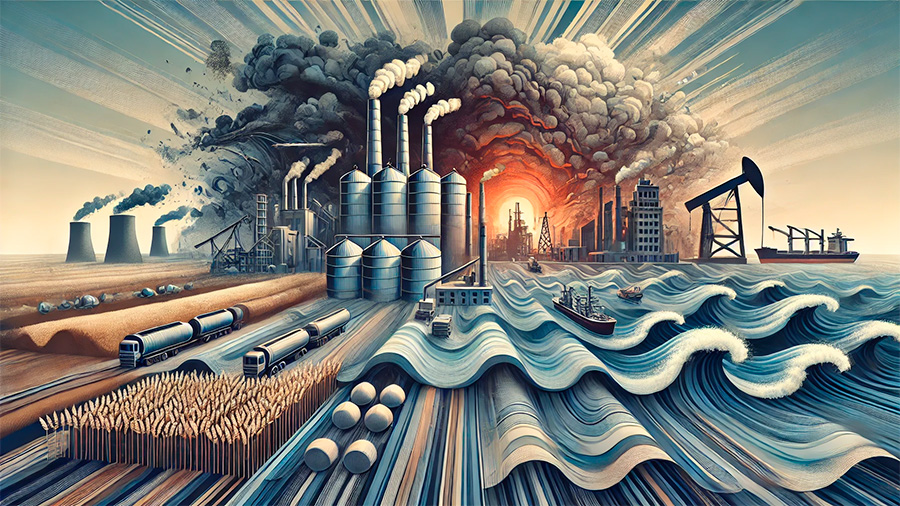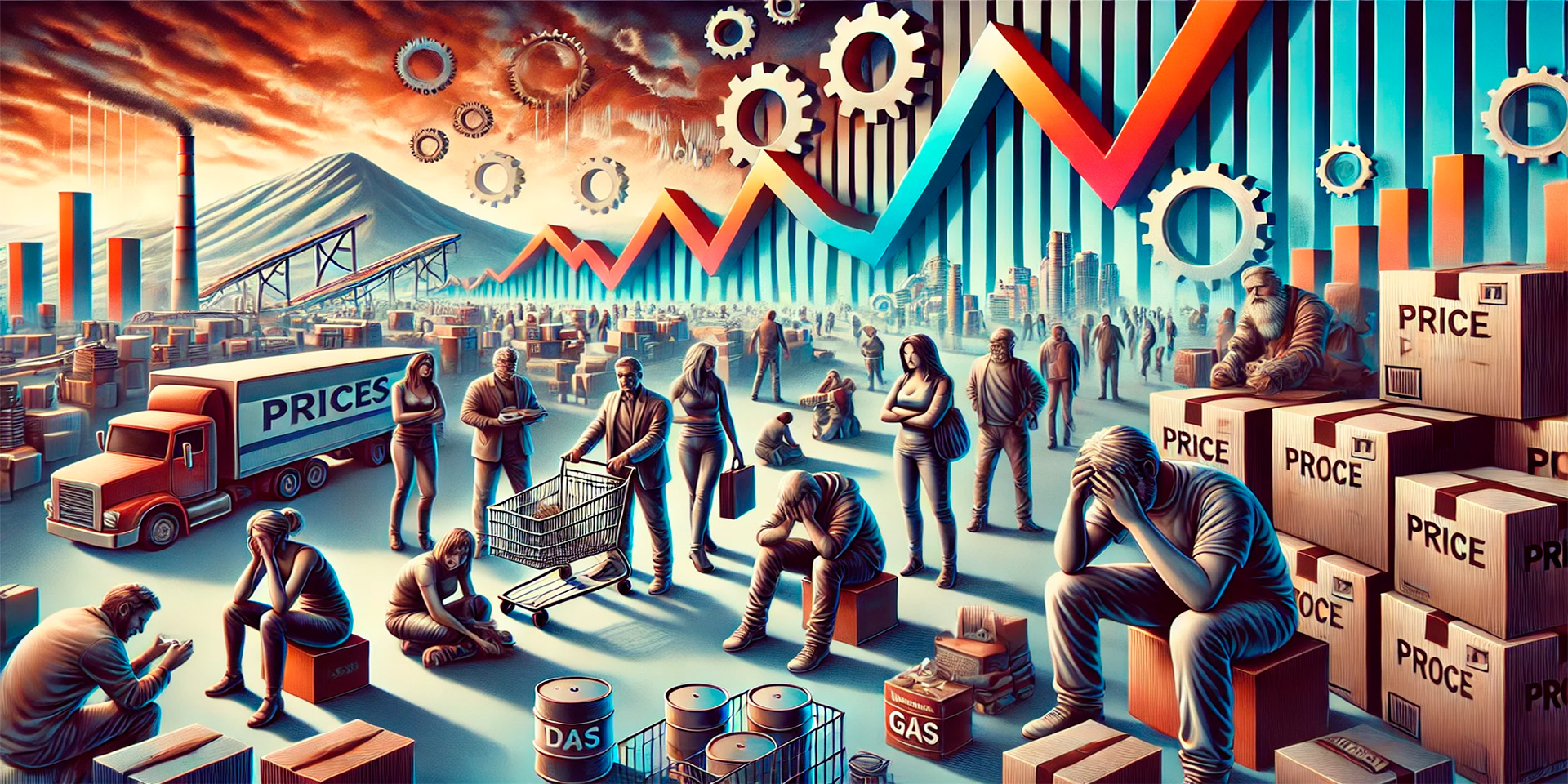During crises—whether they are natural disasters, economic downturns, or global pandemics—prices often surge, leaving consumers struggling to afford essential goods. These price hikes can have significant impacts on households, especially those with limited financial resources. Understanding the reasons behind these rising costs is crucial to grasping how they affect consumer behavior, purchasing power, and overall financial security. Various factors contribute to these price surges, including disruptions in supply chains, increased demand, and market speculation.
Crises strain the economy in multiple ways, leading to price volatility and making it harder for consumers to meet their basic needs. Let’s explore the key reasons why prices surge during crises and examine how these price increases affect consumers’ ability to purchase essential goods.
Supply Chain Disruptions Drive Up Costs
One of the primary reasons prices surge during crises is disruptions in the supply chain. Supply chains are complex systems that rely on the smooth flow of goods from producers to consumers. When a crisis hits, whether it’s a natural disaster or a global pandemic, supply chains often face severe interruptions. Factories may shut down, transportation routes may be blocked, and labor shortages may occur, all of which contribute to reduced supply.
When the availability of goods decreases but demand remains constant—or even increases—prices naturally rise. This is particularly evident with essential goods such as food, medicine, and fuel, which become scarcer during crises. Consumers often face higher prices for these items, as the reduced supply pushes up costs throughout the supply chain.
Transportation and Logistics Bottlenecks
Transportation and logistics are critical components of the supply chain, and any disruptions can lead to delays in the delivery of goods. During crises, transportation networks may be disrupted due to road closures, restricted movement, or fuel shortages. This leads to delays in the movement of goods, increased transportation costs, and ultimately higher prices for consumers. For example, during the COVID-19 pandemic, the shutdown of international shipping routes and air travel led to a sharp increase in shipping costs, which in turn drove up the prices of imported goods.
Labor Shortages and Production Delays
Crises often lead to labor shortages as workers fall ill, face movement restrictions, or are unable to access their workplaces. These labor shortages slow down production and lead to reduced output. In industries like agriculture, where manual labor is essential, a shortage of workers can significantly reduce the availability of fresh produce, driving up prices. Similarly, in manufacturing sectors, the lack of workers can lead to delays in producing essential goods, further contributing to price increases.
Increased Demand for Essential Goods
In times of crisis, consumers often panic-buy or stockpile essential goods, leading to a sudden surge in demand. This increased demand can cause prices to skyrocket, especially if the supply is unable to keep up. The COVID-19 pandemic provided a clear example of this phenomenon, as consumers rushed to buy items like toilet paper, hand sanitizer, and non-perishable foods, leading to widespread shortages and price hikes.
When consumers anticipate shortages, they may purchase more than they need, creating an artificial demand spike that exacerbates the situation. Retailers, faced with depleted inventories, may raise prices to ration goods or capitalize on the high demand, further straining consumers’ ability to purchase essential items.
Panic Buying and Stockpiling
Panic buying occurs when consumers fear that essential goods will become unavailable, leading them to purchase large quantities of these items. This behavior depletes stock quickly and causes retailers to raise prices to manage limited supplies. For example, during the early months of the COVID-19 pandemic, consumers hoarded products such as flour, canned goods, and disinfectants, leading to temporary shortages and price increases. Panic buying can create a vicious cycle, as higher prices lead to more panic, further driving up demand.
Price Gouging in Response to Demand
In some cases, retailers and suppliers engage in price gouging during crises, raising prices excessively to take advantage of heightened demand. Governments often regulate or restrict price increases during emergencies to prevent exploitative practices, but price gouging still occurs in some markets, especially for highly sought-after goods like medical supplies, fuel, and bottled water. Price gouging not only limits consumers’ access to essential goods but also deepens economic inequalities, as lower-income households are disproportionately affected by rising costs.

Raw Material Shortages and Increased Production Costs
Crises often lead to shortages of raw materials, which can increase production costs and contribute to higher prices for finished goods. For example, natural disasters like hurricanes or floods may disrupt the extraction or production of key raw materials, such as oil, grains, or metals. When the supply of these materials decreases, manufacturers face higher costs, which they often pass on to consumers in the form of price increases.
Similarly, during global crises, such as the COVID-19 pandemic, industries dependent on international supply chains faced delays in receiving raw materials, leading to higher production costs. As these costs rise, businesses are forced to raise prices to maintain profitability, further impacting consumers.
Energy and Fuel Price Increases
Energy and fuel are critical inputs in almost every industry, from transportation to manufacturing. During crises, disruptions in energy supplies can lead to significant price increases. For example, oil prices often surge during geopolitical conflicts or natural disasters that affect major oil-producing regions. Higher energy costs translate into increased production and transportation costs, which are passed down to consumers in the form of higher prices for goods and services.
Scarcity of Agricultural Products
Agriculture is particularly vulnerable to crises such as droughts, floods, or pandemics that disrupt farming operations. When crops fail or agricultural production slows due to a lack of labor or resources, the supply of food products diminishes, leading to price surges. This can have a cascading effect, as higher prices for staple foods such as grains, fruits, and vegetables reduce consumers’ ability to afford a balanced diet. Additionally, shortages in agricultural products can lead to price increases for livestock and dairy products, as animal feed becomes more expensive.
Market Speculation and Hoarding
Market speculation and hoarding by investors, retailers, or manufacturers can further contribute to price surges during crises. In uncertain times, market players often speculate on future price movements, buying up commodities or goods in anticipation of higher prices. This speculative behavior can artificially inflate prices, even when there is no immediate shortage of supply.
Hoarding by manufacturers or wholesalers can also limit the availability of goods, pushing prices higher. For instance, during the COVID-19 pandemic, some suppliers stockpiled medical equipment, such as masks and ventilators, contributing to shortages and price hikes. These practices hurt consumers, who are left paying inflated prices for essential items.
Speculative Price Increases in Commodity Markets
Commodities like oil, metals, and agricultural products are often subject to speculative trading during crises. Investors may buy large quantities of these commodities in anticipation of future shortages or price increases, driving up prices in the short term. While speculation is a normal part of market behavior, it can exacerbate price volatility during crises, making essential goods more expensive for consumers.
Hoarding by Wholesalers and Manufacturers
In some cases, wholesalers or manufacturers hoard goods to create artificial scarcity, driving up prices in the process. This practice is particularly harmful during crises when consumers need access to essential goods. Hoarding can lead to long-term supply shortages, forcing retailers to raise prices and leaving consumers with fewer affordable options. Governments often intervene in such situations, implementing regulations to prevent hoarding and price manipulation.

How Price Surges Affect Consumers
Price surges during crises have a direct impact on consumers’ ability to afford essential goods. As prices rise, households—especially those with limited financial resources—are forced to make difficult choices about how to allocate their budgets. Many consumers must prioritize essential expenses such as housing, utilities, and medical care, leaving less money for other necessities like food, transportation, or clothing.
For low-income households, price surges can lead to food insecurity, housing instability, and reduced access to healthcare. Even middle-income families may struggle to absorb the impact of rising costs, particularly if the crisis affects their income or employment status. The overall effect is a decrease in purchasing power, which limits consumers’ ability to maintain their standard of living during challenging times.
Reduced Purchasing Power
As prices rise, consumers’ purchasing power decreases, meaning they can buy fewer goods and services with the same amount of money. This is particularly challenging for households on fixed incomes, such as retirees or those receiving government benefits, who may not see an increase in their income to offset higher prices. Reduced purchasing power forces consumers to cut back on non-essential spending, which can have ripple effects throughout the economy.
Impact on Essential Goods and Services
The price surges during crises tend to affect essential goods and services the most, such as food, healthcare, and housing. This makes it harder for consumers to meet their basic needs, leading to increased financial stress and insecurity. In extreme cases, price increases can push vulnerable populations into poverty, as they struggle to afford the necessities of life.
Conclusion: Navigating Price Surges During Crises
Price surges during crises are driven by a combination of supply chain disruptions, increased demand, raw material shortages, and market speculation. These factors create a perfect storm that raises the cost of essential goods and services, making it difficult for consumers to maintain their standard of living. Understanding the reasons behind these price hikes is essential for developing strategies to cope with their effects.
For consumers, managing rising costs during crises requires careful budgeting and prioritization of essential expenses. Governments and businesses also have a role to play in mitigating the impact of price surges by regulating markets, preventing price gouging, and supporting vulnerable populations. Ultimately, the ability to navigate price surges effectively can help consumers weather the financial challenges that come with crises.

